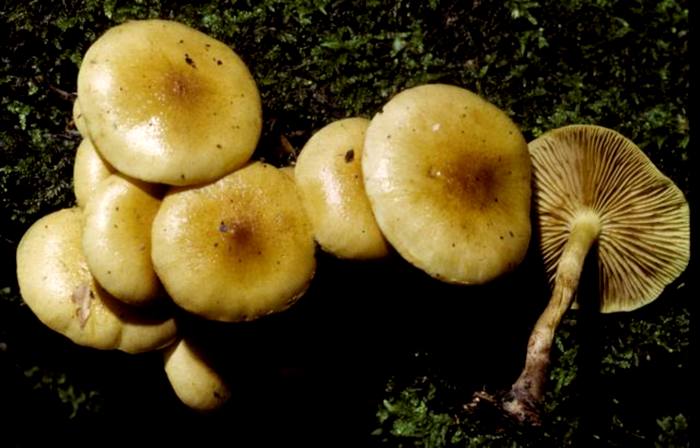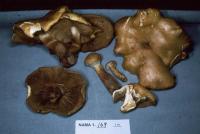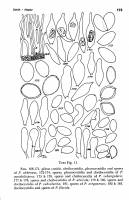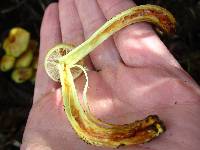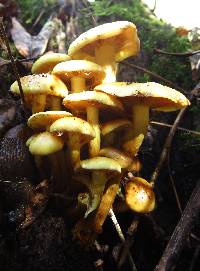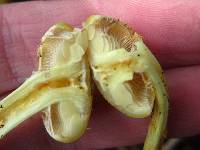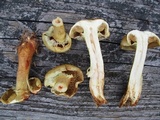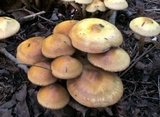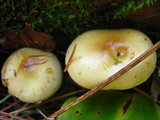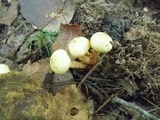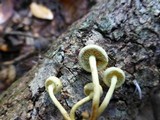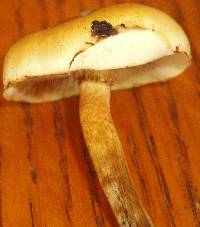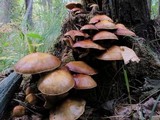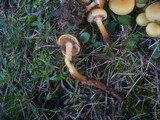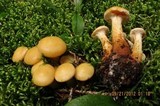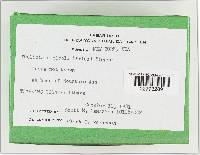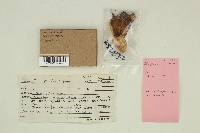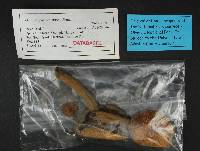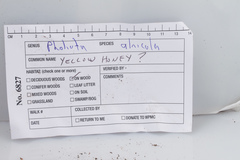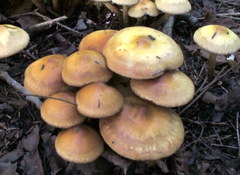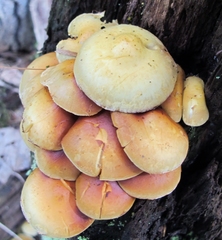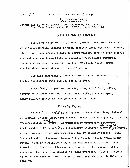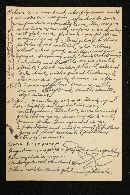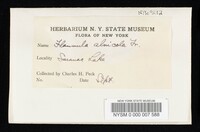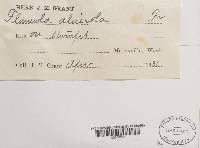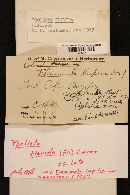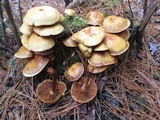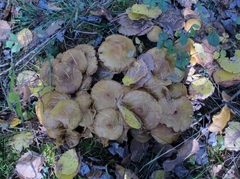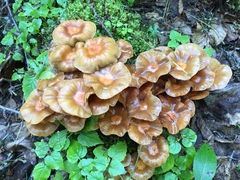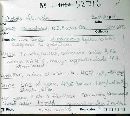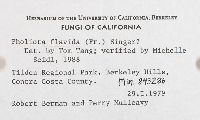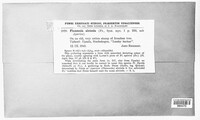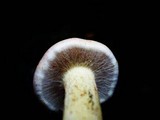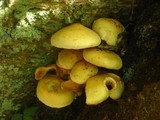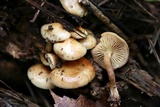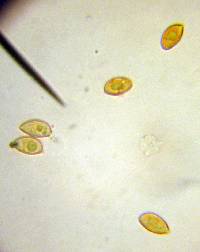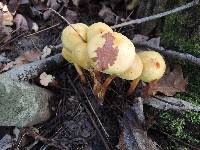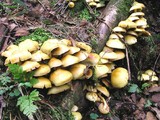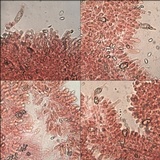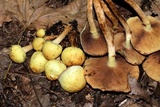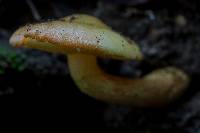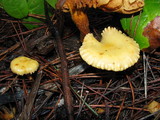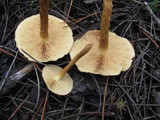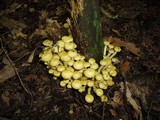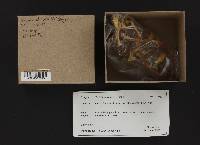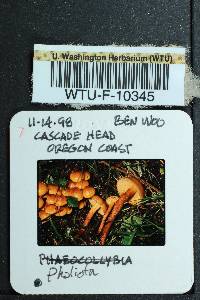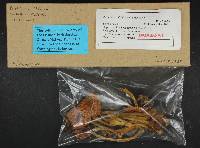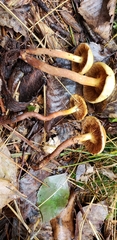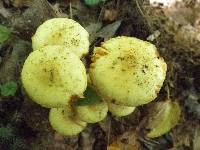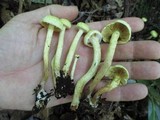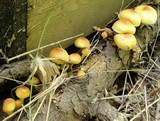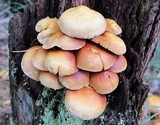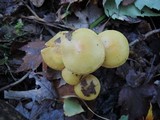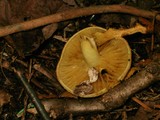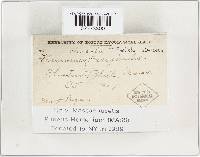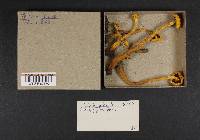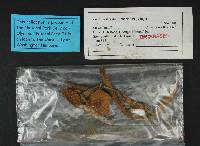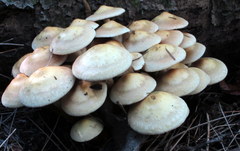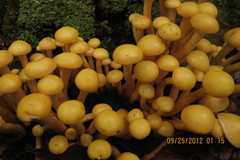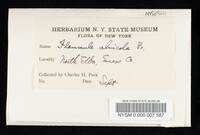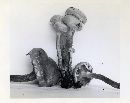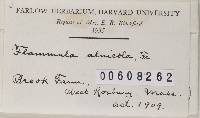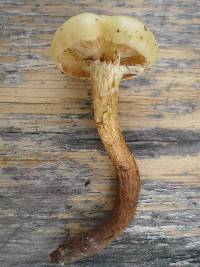
|
|
|
|
Family: Strophariaceae
[Agaricus amarus, morePholiota alnicola var. alnicola (Fr.) Singer, Pholiota alnicola var. salicicola (Fr.) Holec] |
Smith, AH & LR Hesler (1968) The North American Species of Pholiota. Hafner Publishing Company: New York, NY. 86. Pholiota alnicola (Fr.) Singer, Lilloa 22: 516. 1951. Agaricus alnicola Fries, Syst. Myc. 1: 250. 1821. Dryophila alnicola (Fr.) Quélet, Enchir. Fung., p. 71. 1886. Flammula alnicola (Fr.) Kummer, Der Führer in die Pilzkunde, p. 82. 1871. Gymnopilus alnicola (Fr.) Murrill, North Amer. Flora 10: 202. 1917. Illustrations: Text figs. 177-178. Pileus 3-6 cm broad, convex then expanding, at times umbonate, caespitose or fasciculate, not hygrophanous, at first yellow, becoming deeper yellow or ferruginous in age, at times with a flush of olive-green toward the margin, disc at times reddish yellow (Moser), viscid, lubricous, sometimes merely moist, marginal portion fibrillose-subscaly, or appendiculate, glabrescent. Context pale yellow, thick on the disc; odor mild or fragrant to aromatic, taste bitter. Lamellae adnate or slightly rounded behind, at first pallid or pale straw-yellow, finally ferruginous to "ochraceous-tawny," broad, close. Stipe 4-8 (12) cm long, 4-12 mm thick, pale yellow above yellowish becoming brownish from the base up, flexuous, stuffed then hollow, fibrillose. Veil pallid or whitish, evanescent. Spores 8-10 x 4-5.5 µ smooth, apical pore present but inconspicuous; shape in face view subcymbiform to ovate or more rarely elliptic, in profile more or less inequilateral with a broad suprahilar depression, in KOH dark dull cinnamon, in Melzer's more rusty-cinnamon (darker and redder), wall about 0.3 µ thick. Basidia 4-spored, 22-30 x (5) 6-8 µ, obscurely utriform to clavate, in KOH yellowish, in Melzer's yellowish. Pleurocystidia none. Cheilocystidia 22-46 x 3-6 µ, subutriform, fusoid-ventricose or clavate, wall thin smooth and hyaline, content hyaline and homogeneous. Caulocystidia resembling cheilocystidia but typically more elongated. Gill trama of somewhat interwoven hyphae with elongated cells 5-15 µ diam. and nearly tubular, with colloidal content bright red to orange in Melzer's reagent but merely yellowish-hyaline in KOH, walls thin, smooth colorless; subhymenium of narrow (3-5 µ), yellowish, subparallel, non-gelatinous hyphae. Pileus cutis a pellicle of narrow (2-4 µ) subgelatinous (walls lacking sharp definition as revived in KOH), smooth to slightly roughened hyphae, the layer well developed; hypodermial region lacking differentiation from context. Context hyphae interwoven, nearly tubular, content "colloidal" and reddish to orange in Melzer's reagent. Clamp connections present. Habit, Habitat, and Distribution: On hardwood trunks and stumps, at times on conifers, reported from New York (Peck 1898). Observations: The pileus may be viscid, lubricous, or merely moist, depending on the weather conditions. There is also a possibility that the gelatinous surface hyphae of the pileus may slough away, and thus leave the surface "dry." Fries described the pileus as moist, not viscid, and several authors, following Fries, apparently have so characterized it. Our concept is based chiefly on a study of collections by Romell and Maas Geesteranus. Aside from the bitter taste the species is very similar to P. malicola, but since this appears to be such a variable group in North America we have recognized all populations with at least one distinctive character. We need a critical study of some American collections with a bitter taste. Our data are from European specimens. The spores of a collection by Lars Romell (n. 9894) are as given in our description including the moderately strong dextrinoid reaction. The Romell specimen has a well-developed gelatinous pellicle over the pileus. Our disposition of this species is in a sense tentative since there is still a difference of opinion in Europe as to its exact characterization. Favre (1960) for instance, indicated the taste as not bitter. |
|
|
|

